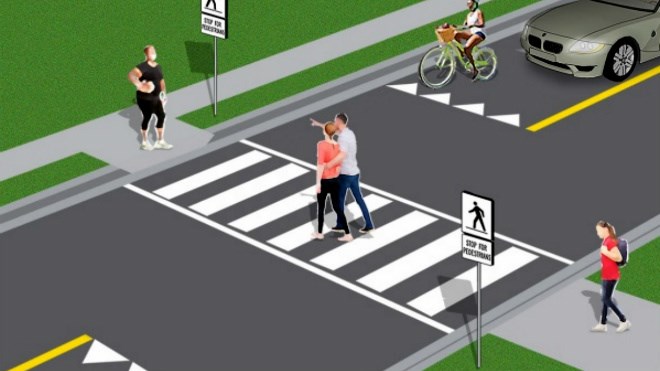Prompted by provincial legislation, the city is bringing in new designs for pedestrian crosswalks, ones aimed at improving safety and preventing tragedies on roadways.
Under amendments to the Highway Traffic Act, the province has approved four designs for pedestrian crossovers – Type A, B, C and D, each with varying degrees of visibility. Three of the designs could appear in Greater Sudbury starting in the fall.
David Shelsted, the city's roads director, told members of the operations committee Monday that the crosswalks are only for roadways where the speed limit is 60 km/h or less and where pedestrian traffic is high enough.
While the new rules are designed to ensure walkers can cross safely, Shelsted said that doesn't mean pedestrians can cross at will – they still must first ensure cars are far enough way that they can safety stop.
While there are four designs available to use, he said the first one – Type A – makes use of overhead yellow flashing lights. The city won't use that design, but will stick with the green-yellow-red lights in use in places such as Paris Street and Ste. Anne Road. That's to avoid confusion over exactly what the yellow flashing light means.
“Everyone understands (green yellow, red),” he said.
Instead, the city plans to use Type B, C and D in 17 intersections that a traffic study concluded are suitable for crosswalks.
Of that total, 13 of them will be the Type D design. It's aimed at areas with lower speed limits and lower traffic volumes. It includes the familiar white stripes painted across the road, as well as white markings on each side of the road showing drivers where they should stop while someone crosses.
They also include signs on both sides of the road alerting drivers that it's a crosswalk. In addition, two Type C crosswalks will be installed. It's the same as Type D, but they're for areas will higher traffic volume and include flashing lights on top of the signs to alert drivers to stop. Two Type B crosswalks are also planned.
They have the flashing signs, as well as arm bars extended across the road to alert drivers.
To qualify for a pedestrian crossover, there must be 100 or more pedestrians who cross during an eight-hour period, or 65 or more in a four-hour period. The crossovers also can't be installed within 200 metres of existing traffic lights, and there can't be more than four lanes of two-way traffic or three lanes of one-way traffic.
“Drivers are required to stop while pedestrian is within a PXO (pedestrian crossover) and may not proceed until completely off the road,” the report into the matter said. “Drivers are not permitted to pass another vehicle within 30 metres of a PXO (and) pedestrians must enter the road only when it is safe and allow vehicles enough time to stop.”
In addition to promoting safety, Shelsted said the crossovers will encourage people to walk more.
“It's going to help the city promote a healthier lifestyle,” he said.
While the crossovers cost about $9,000 each, Shelsted said there will be added costs, including changing parts of sidewalks and roads to accommodate them. Once approved by committee, he said they will develop a detailed design for each and provide updated cost estimate.
“We also need to develop a communications plan to educate the public,” he said. “It's our job to ensure everyone knows what's going on and how to use them safely.”
